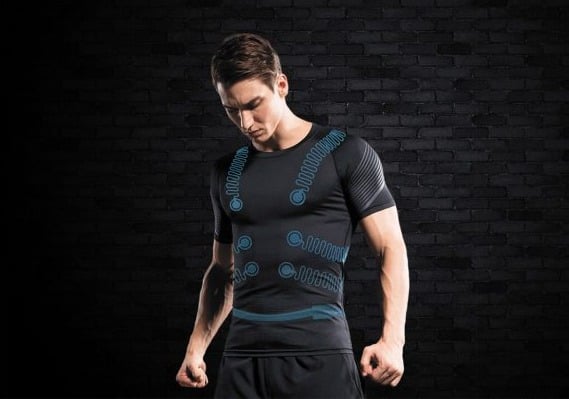The Future of Printed Electronics in Sports
The market for printed electronics is drastically increasing for athletes and within the sporting industry. Through the use of several different printed electronics, athletes can monitor important information about their body’s performance as well as improve their recovery time after games! But what trends can we expect to see increase in future years due to printed electronics?
Biosensors for Athletes:
Biosensors are one of the newest printed electronics that have been on a rapid rise in recent years. Biosensors refer to screen printed biofeedback sensors that are printed in a wide array of configurations that can be implemented into a large variety of different items. In this specific case, we’re regarding the application of biosensors into articles of clothing, such as jerseys.
By simply implementing biosensors into jerseys or uniforms worn by athletes, these athletes will be able to monitor their health vitals. Athletes will be able to monitor respiratory rate, heart rate, or brain activity. However, health vitals aren’t the only benefit of using biosensors.
Biosensors can also be used to monitor muscle activity in athletes. By having biosensors implemented into uniforms, athletes can monitor their muscle fatigue, or how strained their muscles are. They can also monitor muscle activity, or what specific muscles are being utilized during specific activities. For instance, during basketball, you can monitor what muscles are being utilized while playing defense versus what muscles are being used while shooting a free throw or a foul shot. Because these two activities would involve the use of two totally different muscle groups, you’ll be capable of recognizing what muscle groups are being used as well as what specific muscles are being used within the muscle group.
Muscle symmetry is also capable of being monitored, meaning that the equal distribution of strain is being applied to muscles. For instance, in track muscle strain is oftentimes prevalent in runners. For an athlete, they want to ensure that strain is being applied equally to both legs because unequal muscle use can result in injury. By implementing biosensors into jerseys, you can ensure that you’re equally applying pressure between muscles or monitor the muscle symmetry.
Another perk of implementing biosensors into uniforms is the fact you can measure acceleration, speed, and distance traveled. Although this is important in any sport, it’s especially important in sports where running is the main activity, such as cross country. By being able to monitor the speed you averaged during your run, or the distance you traveled, it can be a huge benefit to runners who are training. They can know what they need to improve upon for future events.
E-STIM and TENS for Athletes:
Electrical Muscle Stimulation, oftentimes known as e-STIM or EMS, is a type of biosensor that can be implemented into uniforms for athletes. Electrical muscle stimulation causes repeated muscle contraction, increases blood flow, and helps to repair injured muscles. It’s commonly used to help with recovery time from injury or to help train muscles to respond to the body’s natural signals to contract the muscles. By implementing these e-STIM biosensors into uniforms or clothing worn by athletes, it can help to improve recovery time as well as increase performance within sporting which would be a huge benefit to athletes. TENS is very similar to e-STIM, however, it targets the nerves through electrical stimulation. It can be used to alleviate pain and reduce the recovery time for athletes.
Hydration Sensors for Athletes:
 Hydration sensors are another form of biosensor that can be used to help monitor hydration levels. For athletes, hydration levels are very important to the athlete’s success, so it’s no surprise that hydration sensors would drastically benefit athletes. Hydration sensors could simply be worn as a patch applied directly onto the athlete’s skin that can remotely monitor their hydration levels. This helps, especially in sports, because it can help to prevent dehydration, which would, in turn, improve their performance.
Hydration sensors are another form of biosensor that can be used to help monitor hydration levels. For athletes, hydration levels are very important to the athlete’s success, so it’s no surprise that hydration sensors would drastically benefit athletes. Hydration sensors could simply be worn as a patch applied directly onto the athlete’s skin that can remotely monitor their hydration levels. This helps, especially in sports, because it can help to prevent dehydration, which would, in turn, improve their performance.
Force Sensing Resistors (FSR) for Athletes:
Force Sensing Resistor, usually known as an FSR, is a variable resistor that varies in resistance as pressure is applied and released. In simpler terms, FSRs are capable of measuring pressure that is applied to a surface and monitoring whether the pressure is evenly distributed. The main function of an FSR is to measure the force applied to a specific area, so for athletes, FSRs could find their main function in the footwear they wear. They can monitor the pressure that is being applied and can easily help to track the unequal distribution of pressure. It can help athletes to track not only the pressure being applied but can also help to monitor whether athletes have correct posture. By helping athletes become aware of these things, they will have the opportunity to take corrective action, as well.
Flexible Printed Heaters for Athletes:
 Flexible Printed Heaters are another printed electronic that is on the rise. Printed heaters are warming elements that are capable of being created to specific heating parameters. Although they have several different application opportunities, they’re drastically on the rise in the apparel industry because they are able to be added directly into clothing. For winter athletes such as snowboarders, skiers, or other winter sports, the harsh temperatures are oftentimes hard to withstand. However, by implementing flexible printed heaters into the clothing that these athletes wear, it can provide an element of heat for them. By adding this element of heat, it can help athletes to focus more on the activity.
Flexible Printed Heaters are another printed electronic that is on the rise. Printed heaters are warming elements that are capable of being created to specific heating parameters. Although they have several different application opportunities, they’re drastically on the rise in the apparel industry because they are able to be added directly into clothing. For winter athletes such as snowboarders, skiers, or other winter sports, the harsh temperatures are oftentimes hard to withstand. However, by implementing flexible printed heaters into the clothing that these athletes wear, it can provide an element of heat for them. By adding this element of heat, it can help athletes to focus more on the activity.
Final Thought:
Printed electronics can provide several different unique benefits to athletes. The different application opportunities for printed electronics are endless. If you have any unique applications you’re considering or are interested to learn more about how printed electronics could benefit you, reach out! Our team would be happy to help!
 Meet the Author: Jaclyn King
Meet the Author: Jaclyn King
Jaclyn is a Digital Marketing Specialist on the BTI Team. Her main job responsibilities involve inbound marketing, content creation, and social media management. To get to know more about Jaclyn, check her out on LinkedIn!